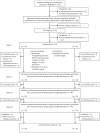Cross-education does not accelerate the rehabilitation of neuromuscular functions after ACL reconstruction: a randomized controlled clinical trial
- PMID: 29796857
- PMCID: PMC6060748
- DOI: 10.1007/s00421-018-3892-1
Cross-education does not accelerate the rehabilitation of neuromuscular functions after ACL reconstruction: a randomized controlled clinical trial
Abstract
Purpose: Cross-education reduces quadriceps weakness 8 weeks after anterior cruciate ligament (ACL) surgery, but the long-term effects are unknown. We investigated whether cross-education, as an adjuvant to the standard rehabilitation, would accelerate recovery of quadriceps strength and neuromuscular function up to 26 weeks post-surgery.
Methods: Group allocation was randomized. The experimental (n = 22) and control (n = 21) group received standard rehabilitation. In addition, the experimental group strength trained the quadriceps of the non-injured leg in weeks 1-12 post-surgery (i.e., cross-education). Primary and secondary outcomes were measured in both legs 29 ± 23 days prior to surgery and at 5, 12, and 26 weeks post-surgery.
Results: The primary outcome showed time and cross-education effects. Maximal quadriceps strength in the reconstructed leg decreased 35% and 12% at, respectively, 5 and 12 weeks post-surgery and improved 11% at 26 weeks post-surgery, where strength of the non-injured leg showed a gradual increase post-surgery up to 14% (all p ≤ 0.015). Limb symmetry deteriorated 9-10% more for the experimental than control group at 5 and 12 weeks post-surgery (both p ≤ 0.030). One of 34 secondary outcomes revealed a cross-education effect: Voluntary quadriceps activation of the reconstructed leg was 6% reduced for the experimental vs. control group at 12 weeks post-surgery (p = 0.023). Both legs improved force control (22-34%) and dynamic balance (6-7%) at 26 weeks post-surgery (all p ≤ 0.043). Knee joint proprioception and static balance remained unchanged.
Conclusion: Standard rehabilitation improved maximal quadriceps strength, force control, and dynamic balance in both legs relative to pre-surgery but adding cross-education did not accelerate recovery following ACL reconstruction.
Keywords: Force control; Maximal voluntary force; Postural stability; Proprioception; Strength training; Twitch interpolation.
Conflict of interest statement
Conflict of interest
The authors declare that they have no conflict of interest.
Ethical approval
All procedures performed in studies involving human participants were in accordance with the ethical standards of the institutional and/or national research committee and with the 1964 Helsinki declaration and its later amendments or comparable ethical standards.
Informed consent
Informed consent was obtained from all individual participants included in the study.
Figures


Similar articles
-
Cross-education does not improve early and late-phase rehabilitation outcomes after ACL reconstruction: a randomized controlled clinical trial.Knee Surg Sports Traumatol Arthrosc. 2019 Feb;27(2):478-490. doi: 10.1007/s00167-018-5116-y. Epub 2018 Sep 4. Knee Surg Sports Traumatol Arthrosc. 2019. PMID: 30182287 Clinical Trial.
-
An anterior cruciate ligament injury does not affect the neuromuscular function of the non-injured leg except for dynamic balance and voluntary quadriceps activation.Knee Surg Sports Traumatol Arthrosc. 2017 Jan;25(1):172-183. doi: 10.1007/s00167-016-4335-3. Epub 2016 Sep 24. Knee Surg Sports Traumatol Arthrosc. 2017. PMID: 27665093 Free PMC article.
-
Cross-education improves quadriceps strength recovery after ACL reconstruction: a randomized controlled trial.Knee Surg Sports Traumatol Arthrosc. 2019 Jan;27(1):68-75. doi: 10.1007/s00167-018-5040-1. Epub 2018 Jun 29. Knee Surg Sports Traumatol Arthrosc. 2019. PMID: 29959448 Clinical Trial.
-
Report of the Clinical and Functional Primary Outcomes in Men of the ACL-SPORTS Trial: Similar Outcomes in Men Receiving Secondary Prevention With and Without Perturbation Training 1 and 2 Years After ACL Reconstruction.Clin Orthop Relat Res. 2017 Oct;475(10):2523-2534. doi: 10.1007/s11999-017-5280-2. Clin Orthop Relat Res. 2017. PMID: 28224443 Free PMC article. Clinical Trial.
-
Neuromuscular electrical stimulation is effective in strengthening the quadriceps muscle after anterior cruciate ligament surgery.Knee Surg Sports Traumatol Arthrosc. 2018 Feb;26(2):399-410. doi: 10.1007/s00167-017-4669-5. Epub 2017 Aug 17. Knee Surg Sports Traumatol Arthrosc. 2018. PMID: 28819679 Review.
Cited by
-
Properties of Knee Joint Position Sense Tests for Anterior Cruciate Ligament Injury: A Systematic Review and Meta-analysis.Orthop J Sports Med. 2021 Jul 15;9(6):23259671211007878. doi: 10.1177/23259671211007878. eCollection 2021 Jun. Orthop J Sports Med. 2021. PMID: 34350298 Free PMC article. Review.
-
Contralateral Effects of Unilateral Strength and Skill Training: Modified Delphi Consensus to Establish Key Aspects of Cross-Education.Sports Med. 2021 Jan;51(1):11-20. doi: 10.1007/s40279-020-01377-7. Sports Med. 2021. PMID: 33175329 Free PMC article.
-
Cross-education and detraining effects of eccentric vs. concentric resistance training of the elbow flexors.BMC Sports Sci Med Rehabil. 2021 Sep 6;13(1):105. doi: 10.1186/s13102-021-00298-w. BMC Sports Sci Med Rehabil. 2021. PMID: 34488881 Free PMC article.
-
Effects of neuromuscular training on knee proprioception in individuals with anterior cruciate ligament injury: a systematic review and GRADE evidence synthesis.BMJ Open. 2021 May 18;11(5):e049226. doi: 10.1136/bmjopen-2021-049226. BMJ Open. 2021. PMID: 34006560 Free PMC article.
-
Quadriceps Activation After Anterior Cruciate Ligament Reconstruction: The Early Bird Gets the Worm!Int J Sports Phys Ther. 2024 Aug 1;19(8):1044-1051. doi: 10.26603/001c.121423. eCollection 2024. Int J Sports Phys Ther. 2024. PMID: 39100933 Free PMC article.
References
Publication types
MeSH terms
Grants and funding
LinkOut - more resources
Full Text Sources
Other Literature Sources

